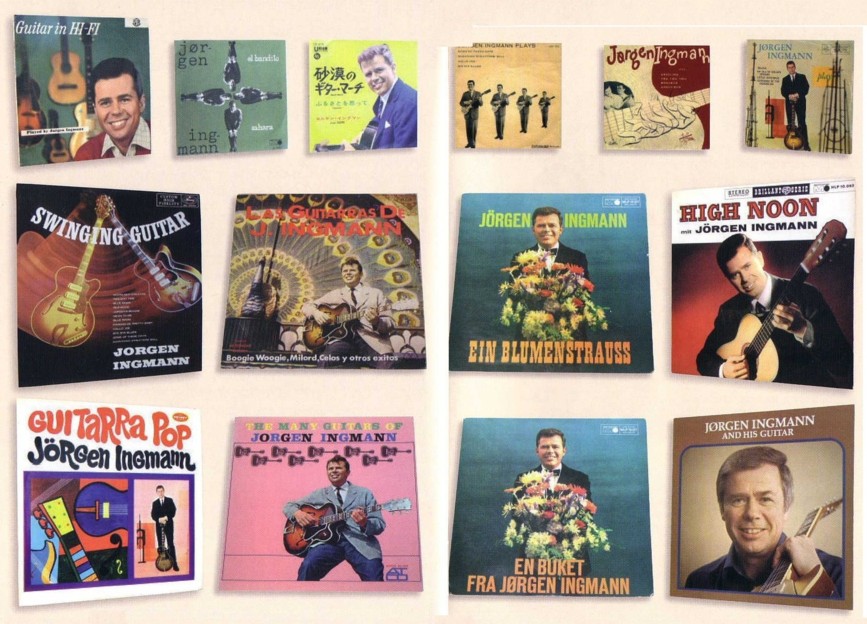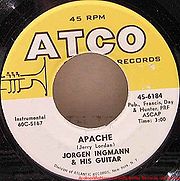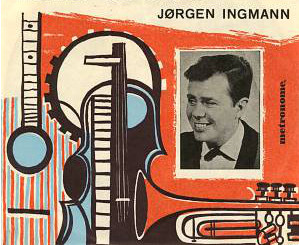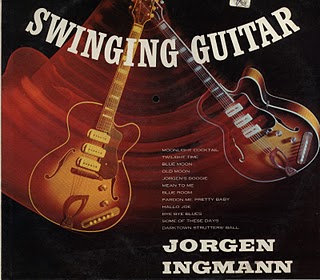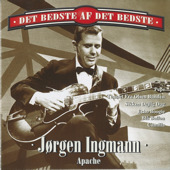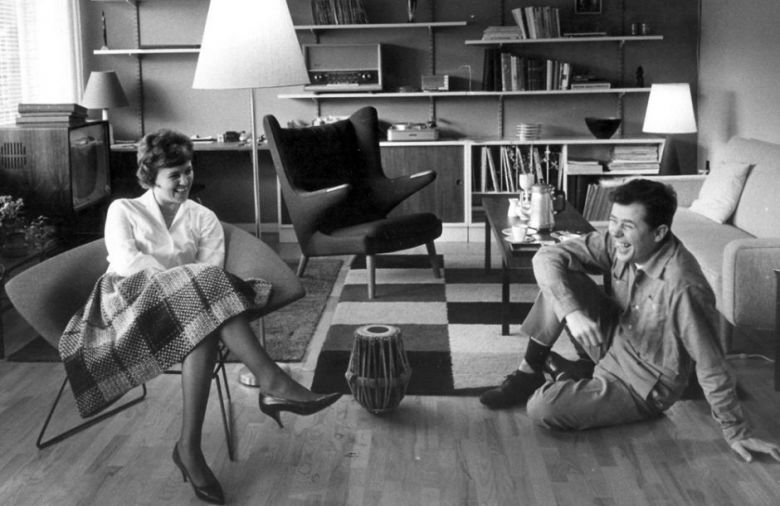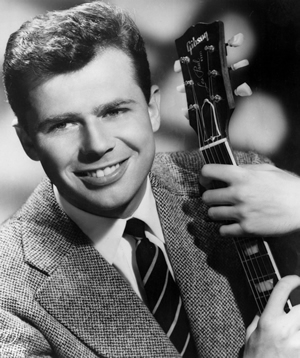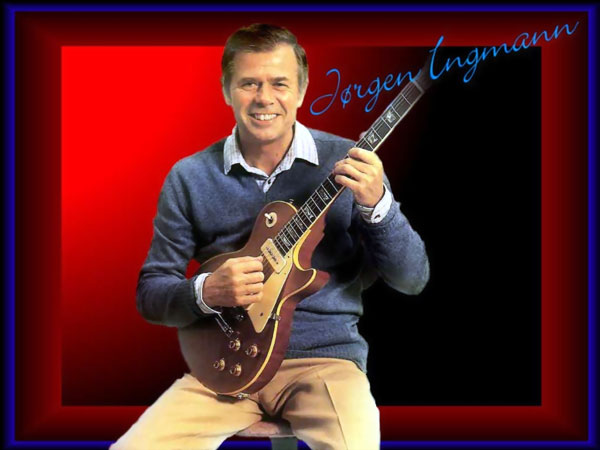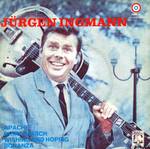Jorgen Ingmann
- a world class Danish guitarist
With his recordings up through the 1950s, Jorgen Ingmann has demonstrated that music with a nerve and atmosphere can be made in a recording studio - even by one musician. Through his music Jorgen Ingmann has become an inspiration for many guitarists, his tecnique being so outstanding, original and precise, that even today he is in a class of his own.
Born in 1925 and passing away 2015, it seems only reasonable to tell his musical merits. This will be done below.
By Kurt Starlit
Seek and thou shalt find...
To document Ingmann's musical career is not an easy task. Most of his recordings are impossible to get hold on and besides, Ingmann was a shy person, keeping out of spotlight, avoiding interviews or publicity. For this reason it came as a lucky strike when, in 2003 a book on Grethe (his wife) & Jorgen Ingmann was released. Titled "Grethe & Jorgen Ingmann" by Herik Kristoffersen, it gives a glimpse of the life and professionel career of two talented artists. From the first part of the book, we read:
When school was over in 1941, Jorgen Ingmann, a young man of 17, was not sure what he wanted to be. So for a period he worked as a messenger. Still living at home with his parents, he was able to save money for his first guitar.
Having been taught in his childhood how to play the violin, he easily transferred the melody lines from the violin to the guitar. He was able to play the melody lines almost immediately, giving him the desire to dip further into more guitar playing.
Ingmann had started an education as a clerck at a printing house, though he felt terribly bored with this work, but nevertheless stayed four long years with the company (1941-45).
Simultaneously Ingmann joined a piano course, learning how to build chords and harmonies. One of his idols were violin player Svend Asmussen.
In 1941 Asmussen & friends opened restaurant Blue Heaven in central Copenhagen. This was the place to dance and hear first class Danish jazz musicians - especially those with a swing.
Having heard American guitarist Charlie Christian, who made an impact on Ingmann, the way Christian played the electric guitar. So far it had only been used as a rhythm instrument in most jazz bands. Christian created a completely new style by using the so-called single-string tecnique, playing single strings.
Apart from learning basic guitar skills by reading a guitar tutorial, Ingmann never got any formal training, and in 1941 he bought his first electric guitar and amp.
As a leasure activity, he soon began to play jazz along with friends, but it was not until he met violin player Arne "Little Arne" Christensen that he formed his first serious group - The Ingmann Quintet (Ingmann-Kvintetten):
Jorgen Ingmann - guitar
Arne "Little Arne" Christensen - violin
Hans Henrik Ley - guitar
Arne Petersen - double bass
"Bubi" - drums
Because they were so eager to get a job, these people were ready to play any venue at any price in Copenhagen 1942. One of the venues were Mayfair in downtown Copenhagen. The band played here many nights, though a curfew was imposed by German occupational power, meaning that Ingmann and everybody else had to be at home by 10 p.m.
To play with professional musicians, Ingmann had to apply for an admission by Musicians Union (Dansk Musiker Forbund). In those days, to become a member of MU, you had to pass an entrance exam. It consisted partly of playing a melody by your own choice (at a certain level of musical calibre), and partly a closely defined job reading and playing from an unknown score.
The reason for these requirements were to assure that you (as a professional musician) were able to read and play notes. In those days, if an orchestra needed a musician, they would call the MU and require e.g. a violin player.
However, with the introduction of jazz (and later rock) musicians, it became obvious that many musicians did not read music very well. For this reason and others, all requirements were dropped many years later in the 1960s.
Ingmann passed the exam, though the union did not posses any guitar notes. The exam was based on classical instruments such as violin, clarinet, piano etc. So, Ingmann had to play his part by reading a banjo note.
One month before finalizing his apprenticeship (1944 that is), Ingmann quit the job as a clerk. He had received an offer to go to provincial town Randers for three weeks, to play with the Roger Henriksen Orch. (Henriksen having heard Ingmann at the Mayfair):
Roger Henriksen - piano
Poul Olsen - violin
Hemming Harmann - upright bass
Helge Jacobsen - electric guitar
Jorgen Ingmann - rhythm guitar (replacing Jorn Grauengaard)
After three weeks in Randers, Ingmann went back to Copenhagen without any jobs at hand, so he started playing with different musicians, e.g. Soren Christensen (violin) and Bent Scharff (piano). They had mutual musical ideas and became good friends as well.
In this period Ingmann also met Bent Fabric (piano) with whom he played many a night at ballrooms and private parties (many years later, in 1961, Fabric released the "Apache" melody, played by Ingmann, on his Metronome label).
A turning point happened in 1945, when his great idol, violin player Svend Asmussen offered him a job as a studio musician (having heard of Ingmann from fellow musicians). Ingmann was flattered and confirmed the offer. The songs recorded were:
"How I'm doing, Hey Hey" and
"That's my weakness now".
This was Ingmann's first recording. The arrangements were written by Asmussen in 1943 during a German imprisonment. Asmussen remembers:
"His soloes are so timeless, they could be recorded today. Right from the beginning the Ingmann style was astonishing perfect. He seemed to know his musical theories very well. You didn't have to tell him what to play, he just knew."
Recording crew:
Svend Asmussen - violin,
Jorgen Ingmann - (electric) guitar,
Paul Hindberg - clarinet,
Bertrand Beck - piano, vibraphone, vocals,
Ulrik Neumann - rhythm guitar, vocals,
Christian Jensen - upright bass and
Soren Christensen - vocals.
The record was released on the TONO label in 1944 (during German occupation), so this was the beginning of a long lasting cooperation between Ingmann and Asmussen.
The peak
1953 is the beginning of a ten year period which is best described as the peak of Ingmann's musical career. In this period he is continously recording, arranging and playing all instruments - "Amorada", "Cherokee", "Echo Boogie" and "Apache" to name but a few, the latter reaching the American charts in 1961 on the ATCO label.
Sound-on-Sound recording
Sound-on-Sound recording, used by most amateurs in those days, means that you are recording one instrument at a time on a tape recorder. The recorder must be able of playing back one track, while simultaneously recording another track. This is a basic example with 4 instruments:
Recording on TRACK 1:
- Rhythm guitar is recorded on track 1.
Recording on TRACK 2:
- Bass guitar is recorded on track 2,
while simultaneously track 1 (rhythm guitar) is transferred to track 2
(this is done by means of a built-in mixer function of the tape recorder).
Rhythm- and bass guitar are now both present on track 2
(volume and sound can no longer be adjusted individually).
Recording on TRACK 1:
- Solo guitar is recorded on track 1
while simultaneously track 2 (rhyrhm- & bass guitar) is transferred to track 1
(this is done by means of a built-in mixer function of the tape recorder).
Rhythm-, bass and solo guitar are now present on track 1
(volume and sound can no longer be adjusted individually).
Recording on TRACK 2:
- Drums are recorded on track 2,
while simultaneously track 1 (rhythm-, bass & solo guitar) is transferred to track 2
(this is done by means of a built-in mixer function of the tape recorder).
Rhythm-, bass and solo guitar are now present on track 2
(volume and sound can no longer be adjusted individually).
The above mentioned sound-on-sound recording means that we have produced a mono recording, consisting of three guitars and drums - all together present on one (mono) track.
To achieve a soundscape in stereo, enthusiasts are doing the above mentioned exercise between two 2-track recorders. To achieve a better or cleaner sound, you'll probably also need to add an external sound mixer, maybe also noise reduction units (Dolby, dbx etc.), noise gates, equalizers etc. But basically the recipe is the same.
Multi-track recording
In the 1950s, at a time when musicians only had acces to 2-track mono recording machines with built-in overdub, Jorgen Ingmann had access to a 4-track recording machine. Developed by Danish ingeneer Philip Foss, this meant that Ingmann could record four parallel tracks, one at a time. In this way he could record four tracks (instruments) without any overdub. Finally the tracks were mixed and equalized into a master track. This meant a considerable improvement in sound quality. Listening to Ingmann's recordings from the 1950s, it sounds like most of the time he is keeping within the four track limit.
We also need to mention Philip Foss and his WIFOS Studios for the invention of the studio-reverb - big, expensive and a dream come true. Until then reverb was obtained by placing the recording artist (e.g. a singer) on top of a stairway, and the recording engineer & equipment at the bottom (people living in the apartments were asked to stay in and keep quiet). Alternatively theatres and big halls were used to obtain reverb or echo.
Half speed recording (HSR)
HSR was a technique which became possible with the appearance of the tape recorder in the fifties. Ingmann used this technique quite extensively. By using HSR, the musical precision of a tune is improved considerably (playing the right note at the right time). Simultaneously the recorded instrument changes its sound in a characteristic way. To demonstrate this, try listening to "Cherokee", which was recorded in two versions,
HSR and
normal speed.
Besides gaining musical precision, the idea of HSR was to achieve a pitch-doubling and/or speed-doubling effect, when the recording was played back at normal speed. These effects were made possible only because of the tape recorder. To demonstrate once more the difference between normal speed and HSR, let's listen to "I may be wrong", which is recorded at normal speed, and "Muskrat Ramble". which is HSR. The difference should be easy to tell.
Life goes on
In 1956 Ingmann married twelve year younger Grethe. She was a jazz singer, and together they had a couple of local hits before winning International Grand Prix 1963 in London with "Dansevise" (Dance Song).
They seemed to be the perfect couple, but nevertheless, some time in mid 70's they got divorced, and nothing was ever the same again, neither for him or for her.
Entering the mid-1960s, Ingmann's musical production changed considerably. No more jazzy tunes with delicate guitar phrasing, which was changed into middle-of-the-road standards for big orchestra plus a stright forward Ingmann guitar in front.
In mid-1970s he signed a financial rewarding contract with the Polydor label meaning, that he once every year was to record an LP with popular songs (e.g. ABBA and Beatles). He released a number of LPs on Polydor, but in my humble opinion not worth mentioning - too little Ingmann and too much orchestra.
With long intervals he gave interviews revealing, that he was never fond of performing in public. He felt at home in the studio, doing his stuff along with fellow musicians and technicians.
1984 was his last public appearance. He was presented as a solo artist, standing on a truck at town festivals etc., playing back (from a tape recorder) some of his well known tunes. He certainly didn't feel at ease at occasions like this, so probably this was a final reason for his retirement from music business.
In 2001 he gave an interview, explaining that he had quit business for good. He had sold his guitars, he just wanted to live a simple and silent life. He had also started painting. He had children and grandchildren, so apparently he lived a good life, being off from the limelight.
In February 2015 we received the sad message that Jorgen Ingmann had silently passed away. He was a nice person and we'll miss his divine guitar touch very much. God bless his musical soul.
=============================================================================
Major recordings
=============================================================================
SINGLES (Single play with one song each side):
Metronome B 1099 (1954), "Alexanders Ragtime Band" / "That's A Plenty"EPs (Extended Play with two songs each side):
Metronome B 1315 (1958), "Little Serenade" / "Trudie"
Metronome B 1343 (1958), "Side Saddle" / "Dalla Strada"
Metronome B 1371 (1959), "Jørgens Boogie" / "Pardon Me Pretty Baby"
Metronome B 1404 (1960), "Gingando" / "Frenesi"
Metronome B 1445 (1961), "Apache" / "Echo Boogie"
Metronome B 1458 (1961), "Pepe" / "Amorada"
Metronome B 1473 (---?--), "Anna" / "Cherokee"
Metronome B 1489 (1961), "Violetta" / "Sweet Talk"
Metronome B 1523 (1962), "Africa" / "Johnny's Tune"
LPs (Long Playing records with 30 minutes playing time each side):
- Metronome MEP 83, "Jorgen Ingmann plays Dixieland"
- "Alexander's Ragtime Band" (Irving Berlin)
"That's a plenty" (Lew Pollack)
"Royal Garden Blues" (Spencer Williams)
"Muskrat Ramble" (Kid Ory)
- Metronome MEP 139 (1955)
"Jorgen's Boogie"
"Mean to me"
"Blue Room"
"Pardon me pretty baby"
- Metronome MEP 1020, "Jorgen Ingmann plays at twilight time" (1959)
- "Old moon"
"Moonlight Cocktail" (Lucky Roberts)
"Twilight time" (Ram, Nevins)
"Blue Moon" (Rodgers)
- Metronome MEP 1082
- "Hello Joe"
"Bye Bye Blues"
"Some of these days"
"Darktown strutters ball"
- Metronome MEP 1164 (1960)
- "Little old Lady"
"Star dust"
"Two sleepy people"
"Rockin' Chair"
- Metronome MEP 1708 (1960)
- "Trudie"
"My isle of golden dreams"
"Little serenade"
"Serenade of the Mandolins"
- Metronome MEP 1790 (1961)
- "Apache"
"Echo Boogie"
"Pepe"
"Amorada"
- Jorgen Ingmann, "Swinging Guitars" (1959)
METRONOME- "Moonlight Cocktail"
"Twilight Time"
"Blue Moon"
"Old Moon"
"Jorgen's Boogie"
"Mean To Me"
"Blue Room"
"Pardon Me, Pretty Baby"
"Hello Joe"
"Bye Bye Blues"
"Some of These Days"
"Darktown Strutter's Ball"
- Jorgen Ingmann, "Guitar in Hi Fi",
Metronome MLP 15007 (1960)- "Margie"
"Qui Zas, Qui Zas, Qui Zas"
"I can't believe"
"Camondongo"
"Jeepers Creepers"
"Stardust"
"Frenesi"
"Two sleepy people"
"Rockin' Chair"
"Little old Lady"
"Gingando"
"I may be wrong"
- Jorgen Ingmann, "Guitar Solos" (33 r.p.m.)
Metronome MLP 15071- "Pepe" (Hans Wittstatt)
"High noon" (Dimitri Tiomkin)
"Pinetop's Boogie Woogie" (Clarence Smith)
"Siamese Children's March" (Rogers & Hammerstein II)
"My Isle of Golden Dreams" (G. Kahn, W. Blaufuss)
"Anna" (el negro zumbon) (Roman Vatro)
"Cherokee" (R. Noble)
"Oh!" (Byron Gay, A. Johnson)
"Twilight Time" (Ram, Nevins)
"Bonanza" (Livingston, Evans)
"Serenade of The Mandolins" (Manlio, Ponzeiti)
"Amorada" (Waldyr de Azevedo )
1960, Grethe & Jorgen Ingmann in their new house.
Photo: Vagn Hansen
When turning 80 in 2005, in a Danish magazine you could read:
I AM.....
In May, 2005, a 4-CD titled Danish Guitar Ace was released. This CD contains most of his well-known recordings.
===============================================
CD 1:
1. Undecided (METRONOME B 1069, 1953) (78 rpm)
2. Dengozo (METRONOME B 1069, 1953) (78 rpm)
3. Angelina (METRONOME B 1068, 1953) (78 rpm)
4. You, You, You (METRONOME B 1068, 1953) (78 rpm)
5. Oh! (METRONOME B 1075, 1954) (78 rpm)
6. Alexander's Ragtime Band (METRONOME B 1099, 1954) (78 rpm)
7. That's A Plenty (METRONOME B 1099, 1954) (78 rpm)
8. Royal Garden Blues (METRONOME B 1100, 1954) (78 rpm)
9. Muskrat Ramble (METRONOME B 1100, 1954) (78 rpm)
10. Moonlight Cocktail (METRONOME MEP 1020, 1955)
11. Twilight Time (METRONOME MEP 1020, 1955)
12. Blue Moon (METRONOME MEP 1020, 1955)
13. Old Moon (METRONOME MEP 1020, 1955)*
14. Jørgen's Boogie (METRONOME MEP 139, 1959)
15. Mean To Me (METRONOME MEP 139, 1959)
16. Blue Room (METRONOME MEP 139, 1959)
17. Pardon Me, Pretty Baby (METRONOME MEP 139, 1959)
18. Hello Joe (METRONOME MEP 1082, 1956)
19. Bye Bye Blues (METRONOME MEP 1082, 1956)
20. Some Of These Days (METRONOME MEP 1082, 1956)
21. Darktown Strutters Ball (METRONOME MEP 1082, 1956)
22. Perhaps, Perhaps, Perhaps (Quizas, Quizas, Quizas)
(METRONOME MEP 1163, 1958)
23. Camodongo (METRONOME MEP 1163, 1958)
24. Frenezi (METRONOME MEP 1163, 1958)
25. Gigando (METRONOME MEP 1163, 1958)
26. Margie (METRONOME MEP 1162, 1959)
27. Jeepers Creepers (METRONOME MEP 1162, 1959)
CD 2:
1. I Can't Believe... (that you're in love with me) (METRONOME MEP 1162, 1958)
2. I May Be Wrong (METRONOME MEP 1162, 1958)
3. Little Ol' Lady (METRONOME MEP 1164, 1958)
4. Stardust (METRONOME MEP 1164, 1958)
5. Two Sleepy People (METRONOME MEP 1164, 1958)
6. Rockin' Chair (METRONOME MEP 1164, 1958)
7. Trudie (METRONOME B 1315, 1959)
8. Dalla Strada (Angelina) (METRONOME B 1343, 1959)
9. Side Saddle (METRONOME B 1343, 1959)
10. Cherokee (METRONOME MEP 1791, 1961)
11. Pinetop's Boogie-Woogie (METRONOME MEP 1791, 1961)
12. Anna (El Negro Zumbon) (METRONOME MEP 1791, 1961)
13. Sweet Talk (METRONOME B 1489, 1961)
14. Oceans Of Love (METRONOME B 1477, 1961)
15. Johnny's Tune (METRONOME MEP 1804, 1962)
16. Marie (METRONOME MLP 15168, 1965)
17. Alone (METRONOME MLP 15168, 1965)
18. Sleepy Time Gal (METRONOME MLP 15168, 1965)
19. Serpentina (METRONOME MLP 15168, 1965)
20. Misty (METRONOME MLP 15168, 1965)
21. Sunrise Serenade (METRONOME MLP 15168, 1965)
22. In The Shadows (METRONOME MLP 15168, 1965)
23. Little Man, You've Had A Busy Day (METRONOME MLP 15168, 1965)
24. Beyond The Sea (La Mer) (METRONOME B 1613, 1964...&...MLP 15168, 1965)
25. Jazz Me Blues (METRONOME MLP 15168, 1965)
26. Blue Sky (Blauer Himmel) (METRONOME MLP 15168, 1965)
27. Tovarisch (METRONOME B 1592, 1964...&...MLP 15168, 1965)
CD 3:
1. Apache (METRONOME B 1445, 1960)
2. Echo Boogie (METRONOME B 1445, 1960)
3. Pepe (METRONOME B 1458, 1961)
4. Amorada (Brasileirinh) (METRONOME B 1458, 1961)
5. Bonanza (METRONOME MEP 1799, 1961)
6. Toy Balloons (METRONOME MEP 8804, 1962)
7. High Noon (METRONOME B 1484, 1961)
8. Camilla (METRONOME B 1545, 1963)
9. Batucada (METRONOME B 1545, 1963)
10. Drina-march (METRONOME B 1575, 1963)
11. The Missing Link (Ukraine) (METRONOME B 1575, 1963)
12. Desert March (La Longue Marche) (METRONOME B 1592, 1964)
13. The Bandit (El Bandito) (METRONOME B 1614, 1964)
14. Sahara (METRONOME B 1614, 1964)
15. Corfu (Korfu) (METRONOME B 1638, 1966)
16. Seven Roses (METRONOME B 1638, 1966)
17. Zorba (METRONOME B 1626, 1965)
18. This Is My Song (METRONOME B 1684, 1967)
19. Django (komponist:Enriques) (METRONOME B 1684, 1967)
(ikke at forveksle med Mogens "Django" Petersen's melodi af samme navn)
20. This Guy's In Love With You (METRONOME B 1703, 1968)
21. Wishin' And Hopin' (METRONOME MLP 15345, 1969)
22. The Sea Is My Soil (METRONOME MLP 15345, 1969)
23. Summerwind (METRONOME MLP 15345, 1969)
24. Fresh Air (METRONOME B 4122, 1975)
25. Trumpet Polka (METRONOME MLP 15605, 1976)
BONUS CD:
1. How'm I Doin', Hey Hey (TONO SP 4367, 1944)
2. Delicado (METRONOME MEP 36, 1953)
3. Samba For Sale (METRONOME MEP 12, 1952)
4. Amorada (Brasileirinho) (METRONOME MEP 11, 1952)
5. Cavaquinho (Svend Asmussen Orch., 1958)
6. Lullaby Of Birdland (1955, not previously released)
7. Jazz Me Blues (1955, not previously released)
8. Pardon Me, Pretty Baby (1955, not previously released)
9. Avant De Fonnues (1955, not previously released)
10. Roses Of Picardy (1955, not previously released)
11. Undecided (1955, not previously released)
12. I Can't Believe... (1957, not previously released)
13. Two Sleepy People (1957, not previously released)
14. Champion Cha Cha Cha (1960)
15. Muskrat Ramble (1960)
16. Milkshake Twist (1962)
17. Tarzan (Tarzan The Ape Man)
18. Gorilla (ATCO 45-6370, 1965, released as a single in USA)
19. Opus 5 (recorded 1968, not previously released)
20. Baby Elephant Walk (1968) (recorded 1968, not previously released)
21. Echo Boogie 1972 (METRONOME M 25 474, released as a single in Germany)
22. I Loved You (Dansevise) (STARBOX LX 60030, 1981)
Have you got any information or comment on Jorgen Ingmann, don't hesitate to write:
